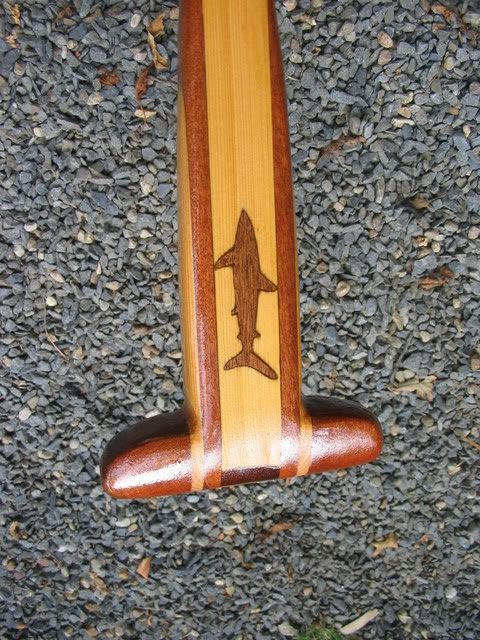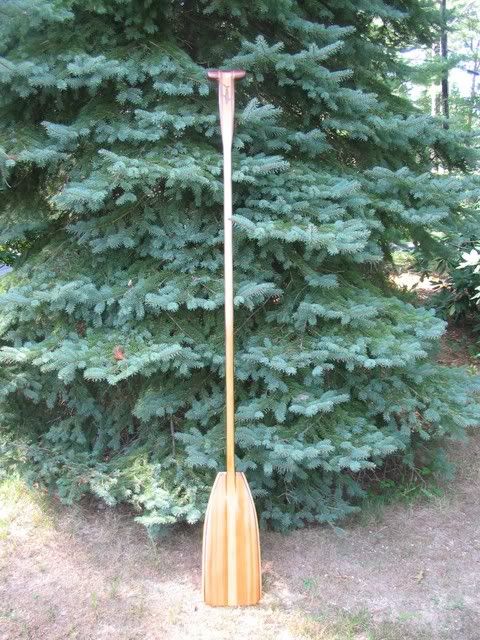When you are ready, we can build a paddle together. I am getting another piece of basswood 12’ x 8" x 1" on July 21 from Architectural Woods. This is what I use for the shaft.
let me know,
D
When you are ready, we can build a paddle together. I am getting another piece of basswood 12’ x 8" x 1" on July 21 from Architectural Woods. This is what I use for the shaft.
let me know,
D
Uncle D,
What kind of wood will you be using for the blade? I'll probably go 100% poplar for mine. I'd like to see what the final weight will be for a stand up paddle. I'll need to plane some of the pieces to 1/2 in. or 3/8 in. thickness before I laminate them together. If I have some other contrasting wood I may use thin strips in the blade.
mokulele
Mokulele:
I am using balsa because it’s light and easy to shape. I glass with 4 oz. s-glass, 5.7 oz. carbon fiber and epoxy for strength. My next generation of paddle blades will be made from high density foam(sandwich construction) and carbon fiber/epoxy covered. I have started making a vacuum pump to suck down the lam job really tight. These are new grounds for me with a lot to learn.
thanks,
D
Here are some ideas that I have been using. This may be a bit slow in coming out. I’m trying to finish a board for my trip. If I can get that done, I will have more info about how I make paddles. I thought I would start with wood selection. I’m not a know-it-all, so if I get something screwed up, please let me know. I also don’t know what people know so don’t beat me up for keeping it simple and some what detailed.
Everything Doug has said is right on. I have a picture (haft.jpg) to help a little more. My glue lines are not oriented as Doug says because I like to hide the core by tapering it to be ~4” short of the tip. But I have the grain oriented to make the best use of the wood’s strength. I would also like to note that I have yet to have a paddle fail in 7 years, and I beat the crap out of them (and so do a couple of my friends). Rivers are shallow, rocky and the paddles get well used.
When I buy wood for these projects the wood is as thick or thicker than the shaft and Plain sawn. Meaning, that if you were to look at the end of the board the wide side of the board is tangent to the growth rings. (See sketch.) Then I rip-cut parts off of the board that are 90 deg. to the wide side of the board, and end up with quarter sawn pieces. This gives you the best strength in the direction of use in the paddle. The core should be oriented in the same direction.
The clamp pics are of the clamp system that I use to keep the shaft straight during the glue up. I use turn buckles to apply pressure and a couple of 2x2s with a slot to the keep the turn buckles in place. I have a wider unit to clamp the blade to the shaft. For the blade clamp I do have to use a clamp to hold the paddle flat to the table. I do use a “C” clamp on the ends to get the plates to stay put. The plates are trying to spring back hard.
More as I can… wish I could say I HAD to go surfing, but I need to go fill the weave on my newest board. (temps are falling)
Hafte


So true about the strength of wood. I built one with an oak center piece and a split walnut staff. The oak is a 3/8" thick trim piece which was originally 5.5" wide. That allowed me to cut the 10* bend at the bottom 15" for the blade, without any scarfing & gluing. The edge of the oak before the bend became the middle of the shaft. I did split the walnut staff with my table saw…
The blade is glass-CF-glass-1/8" d-cell-glass-CF-glass. Its such a strong & light composite, I finally feel like I understand how things like Stealth Bombers are made of this stuff. Its all epoxy and I laminated it all in one shot, with 2 pieces of scrap granite countertop for pressure. Actually, one on the bottom for a super flat surface and one on top for pressure. If you can ever find a countertop guy with a few scrap pieces, they are awesome for so many shop uses - as flat as a glass panel for things like sharpening plane blades or laying up fin panels, and also very heavy for clamping pressure, and epoxy doesn’t stick, so once cured, you just hit the edge of your piece with a putty knife and it pops right off…
Aloha Benny:
I was waiting for you to jump in. I think your ideas and techniques are very solid. In fact I am going to incorporate the high density foam / CF along with the laminate shafts in my next generation of paddles. Do you have pictures of the finish paddle?
Anyway, thanks again for your contribution.
Mahalo,
D
Sorry, D, I haven’t taken any photos in a while. My camera’s card is full from vacation and I need to sort & store before I let myself delete anything off of it…
Just as bad as sorting celluloid into albums, when it comes down to it ![]()
Thanks for the compliments, though. It does work very nicely and is crazy light…I haven’t done a lot of stand-up with it, but I have put in some time paddling a canoe with it while standing. Easier to see the fish that way ![]()
Uncle d, am I correct that the shaft dimensions should be about 1.5X 1 and rounded? I’ve never seen one live. My plan is to use two boards 1/2-inch by 6-inches wide and 6 feet long, and sandwich a 6-inch layer of carbon fiber in between with epoxy and then rip into three 6 ft shafts.
thx for the great thread
I usually get the shaft 1 3/8" h x 1" w before I start to whittle the corners but that’s me. Find the size that fits your hands just right. It’s like tennis rackets or golf clubs grips. You need to find the size that you are comfortable with. This also applies to the blade angle. I seem to like 14 degrees because I can set the blade up front and pull hard on it. The same goes with blade width (8" to 9.5"). To narrow and you are not getting enough power and two wide will burn you out too quickly.
Please post pictures of you paddles. I have learned so much from the other’s postings.
Thanks,
D
Great post…wish I had found it before I started building a paddle. I’ve just built a couple and while they look great I’m concerned they may be heavy. What is a reasonable weight for a wooden SUP paddle? I used 1/4" cedar strips laminated to make the shaft and the blade.
When I have the time I’ll post the process here. Until then here are a couple of pictures and you can see a blog on the process here.
http://lumberjocks.com/jocks/Treefarmer/blog/1738
Handle of the 1st

The rest…

Stoneaxe:
I never did weigh my paddles because they are only about 10 - 20% heavier than a carbon paddle (by feel). I used light woods like balsa and basswood so weight was was never an issue. Glassing with epoxy and carbon made the light woods stronger.
Your paddle looks great. I suck at wood work that is why I try to keep my paddles simple. For my next two paddles, I glued up high density foam for the blades on to basswood shafts. I have them glued up but I need to find the time to complete them.
Issues on weight: If it feels heavy after 30 minutes of paddling. then it’s too heavy. I remember seeing the early beachboys like Pops Ah Choy using rowing oars as paddles. They surfed for hours with their simple 10 -12’ logs using their oar paddles. I used some hard wood paddles from China that looked good but was so heavy.
I love the feel of wood paddles. I have a bunch of wood to mill and to make more paddle shafts.
Check out the SUP paddles by Greg Tate (he did a high density foam paddle) and the great wooden paddles by Mokulele. These guys raise the bar and inspire me.
Aloha,
D
D
Thanks for the weigh in…![]()
I managed to get them weighed tonight. The one in the picture is the heavier of the two. Came in at 2 lbs 8 oz, the other is 2 lbs. I think that should be pretty good. I’m hearing anywhere from 30 oz to 3 lbs is pretty common. I built the 1st with 6 laminations, 4 cedar and 2 mahogany, the second with 5 laminations, 4 cedar and 1 mahogany. The next one will be all cedar. Should get me down to 30 oz or under.
I’ll have to check out the HDF sounds interesting. Be nice to marry a veneer of something exotic to it. Any secrets to the glue up?
I’ll have to see if I can get some basswood to try. The only thing is the eastern cedar is cheap out here and nice and light. I can also get some nice color variations. I might also try some clear white pine.
Those guys must have been in some kind of amazing shape. Great history to the sport.
Thanks again.
I seem to like 14 degrees because I can set the blade up front and pull hard on it.
Finally finishing my SUP paddle. I noted that you refere to 14 degrees for the shaft angle. I put 10 degrees on mine. I guess I will have to start over and make another one. It’s cedar and balsa and Basswood. Should burn pretty good. I wish I read your post earlier? At least I get to pratice!
Anything from 9 to 15 degrees should work fine. It's the paddler's choice.
Thank’s Uncle.
So 10 degrees will be OK? I guess I can make a few with different angle and see what’s best for me. I’m just a hacker trying to live the dream.

10 degrees should work.
UncleD,
I am brand new to Swaylock and for years i’ve lived far from the waves (but not the sea). This question is about the durability of the scarf-joint shown in your images. How has this sup paddle held up?
Thanks!
Spucebreeze
I haven't broke a paddle on the joint yet. I did snap a paddle on the shaft when I fell on it while surfing.
Clasic thread Uncled. I had forgotten all about this one. Such nice work you do.